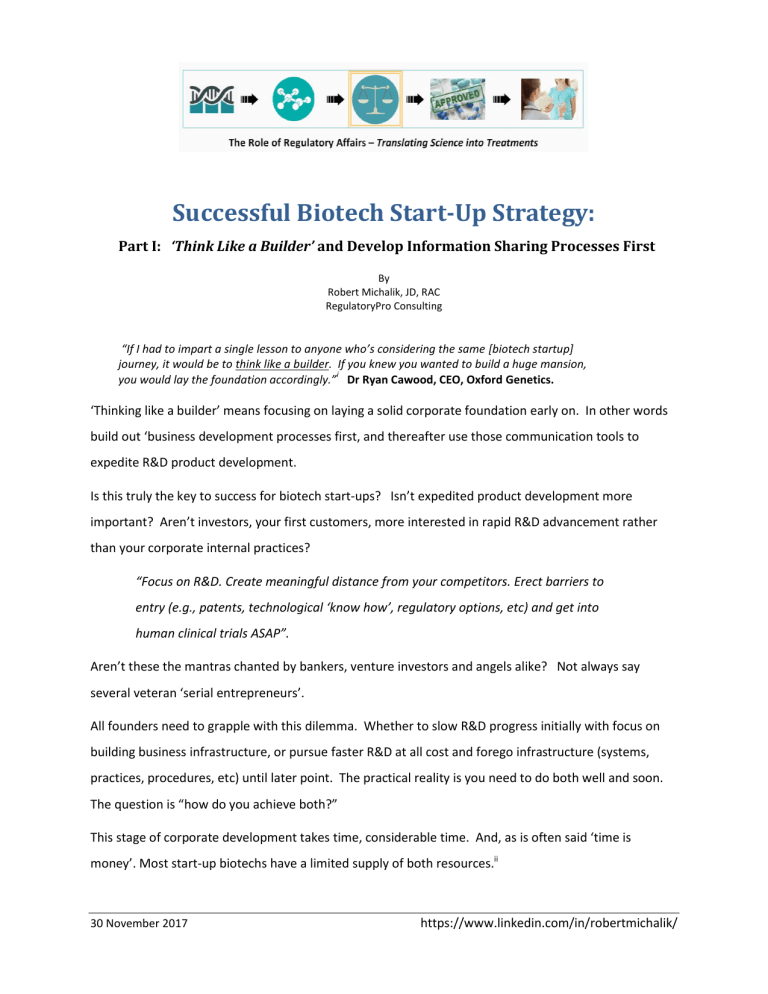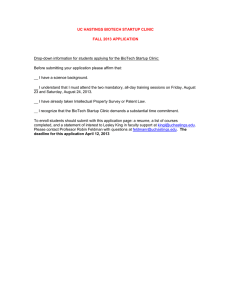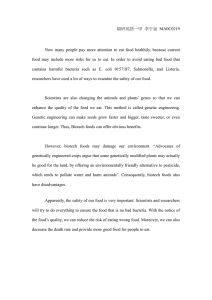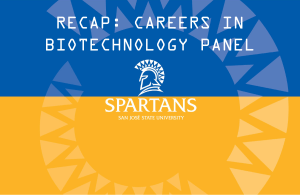
Successful Biotech Start-Up Strategy: Part I: ‘Think Like a Builder’ and Develop Information Sharing Processes First By Robert Michalik, JD, RAC RegulatoryPro Consulting “If I had to impart a single lesson to anyone who’s considering the same [biotech startup] journey, it would be to think like a builder. If you knew you wanted to build a huge mansion, i you would lay the foundation accordingly.” Dr Ryan Cawood, CEO, Oxford Genetics. ‘Thinking like a builder’ means focusing on laying a solid corporate foundation early on. In other words build out ‘business development processes first, and thereafter use those communication tools to expedite R&D product development. Is this truly the key to success for biotech start-ups? Isn’t expedited product development more important? Aren’t investors, your first customers, more interested in rapid R&D advancement rather than your corporate internal practices? “Focus on R&D. Create meaningful distance from your competitors. Erect barriers to entry (e.g., patents, technological ‘know how’, regulatory options, etc) and get into human clinical trials ASAP”. Aren’t these the mantras chanted by bankers, venture investors and angels alike? Not always say several veteran ‘serial entrepreneurs’. All founders need to grapple with this dilemma. Whether to slow R&D progress initially with focus on building business infrastructure, or pursue faster R&D at all cost and forego infrastructure (systems, practices, procedures, etc) until later point. The practical reality is you need to do both well and soon. The question is “how do you achieve both?” This stage of corporate development takes time, considerable time. And, as is often said ‘time is money’. Most start-up biotechs have a limited supply of both resources.ii 30 November 2017 https://www.linkedin.com/in/robertmichalik/ RegulatoryPro Consulting Page 2 Managing during this earliest stage in a company’s evolution is much like a ship setting sail from a harbor, while it’s still under construction. Restricting R&D activities until the company’s planning, organizational and reporting systems are adequately established slows product development. Such delays can open the door for competitors to leap ahead, a catastrophe akin to taking on water before sinking. On the other hand, if you expedite R&D work before management systems are adequately in place, you create the risk that the R&D data generated will not comply with regulatory prerequisites, that ultimately will support your investigational new drug (IND) applications later on. Being cautious and being successful are sometimes mutually exclusive. Either outcome results in delays. With a thoughtful plan, precise execution and a little luck, it is possible to successfully enter the “R&D race” and complete the ‘corporate hull’ before you pass the choppy breakwaters of FDA IND submission and entry into clinical trials. In this article, we will frame the underlying factors that contribute to slow development and compliance problems. In the second article in this two-part series, we will explore regulatory strategies that address this common startup dilemma and can mitigate the risks and regulatory compliance challenges. In the beginning, there was a vision of success In most cases, it’s an individual –a scientist, engineer or business executive, who provides the spark that starts a biotech company. With a good idea in mind and an entrepreneurial drive, the founder decides to build his/her ‘biotech ship’ and set sail. As skipper, the ultimate goal or vision is clear to him or her, but the Founder know it cannot be accomplished alone. Other skilled professionals from a range of disciplines will be needed. Finding and attracting the ship’s crew will take time and money. In the meantime, more competitors begin to appear on the radar and time becomes a limiting factor. Once a cadre of business, R&D, legal and regulatory “C-level” experts are on board, the founder’s original vision is translated into an actionable, albeit high-level business development plan. The finance CFO, technology CTO and development CDO are delegated authority and responsibility for breathing life into their own department organizations. The immediate development milestone is crystal clear: successfully draft and submit an IND to FDA, obtain clearance and begin with clinical investigations in human subjects. 26 March 2018 https://www.linkedin.com/in/robertmichalik/ RegulatoryPro Consulting Page 3 Departments’ tactical plans are implemented and progress appears underway. This initial phase of biotech corporate development is critical. Until a critcal mass of functional skills are acquired and department-level plans are in motion, little significant progress can be made at the corporate level. Delays impact timelines, pressure mounts and the urge to initiate expensive R&D activities (i.e., chemistry, manufacturing and quality control development) becomes irresistable. Corporate development begins to lag behind product development. The cart is ahead of the horse, so to speak. This inevitably leads to pernicious inefficieny and the predictable outcome is both deleterious and preventable. First-in-Human Clinical has Several Advantages, and perhaps even First to Market Efficient drug development can yeild attractive financial rewards. In the current regulatory environment, a biotech company who submits to FDA a persuasive IND application for ‘breakthrough therapeutic product’ will likely be rewarded with several advantegous regulatory incentives, including Fast Track regulatory pathways, and Orphan Drug designation which provides tax credits for qualified clinical testing , and exemption from the prescription drug user fee. Thereafter, if the initial Phase I/II clinical studies begin to show compelling results, FDA may grant accelerated approval to expedite product review and market access. For biotech companies developing a therapy for rare illness affecting children, a particularly valuable incentive to seek would be a Rare Pediatric Disease Priority Review Voucher. This is a fungible asset that can be redeemed by a sponsor later (or sold to a third party) to receive Priority Review of a subsequent marketing application for a different product. Establish a Virtual Hive Communication System To gain these regulatory incentives, first a fully integrated quality and regulatory platform must be established to speed development and lend credibility to the ‘expensive data’ you’ve generated to support the marketing application. Because humans are not bees or ants, a ‘hive communication mentality’ is not possible. Ideas have to be shared, plans proposed, risks weighed, options challenged and ultimately executed seamlessly. The broader corporate strategy must be refined into a granular tactical plan for each department. Simply drafting policies and standard operating procedures to drive well known higher level activities won’t cut it. What is needed is an information management system that mirrors ‘how’ startup managers actually 26 March 2018 https://www.linkedin.com/in/robertmichalik/ RegulatoryPro Consulting Page 4 interact with each other and how breakthrough therapeutic products and processes are developed. This necessitates the integration of essential and selected good regulatory “GxP” practices into a lean cloudbased operations management platform (GxP = good laboratory practices, good manufacturing practices, good clinical practices, good submissions practices, etc.) see FDA-endorsed ICH.org for detailed descriptions. Granular directions permit delegation to junior level staff member while retaining a modicum of control over the outcome of each process. Without a robust GxP-based operations management approach toward systems development, the perplexing ‘how to proceed’ tactical questions are poorly addressed, if ever at all. What evolves is an organic, non-compliant system that inefficiently connects intra- and inter-departmental activities. FDA compliance gaps appear, and the data that are generated don’t always support higher-level regulatory requirements. Quality Management Systems are more efficient than Innumerable Planning Sessions. Without a tightly woven, lean, cloud-based regulatory-compliant system to facilitate information sharing, the senior management team tends to hold more meetings to exchange information and iron out a tactical plan as they go. Valuable time is wasted in meetings to discuss activities that appear urgent, but not necessarily important at the particular stage of product development. Most of these meetings end without clear decisions, and so, more meetings are needed. Projects lag, business stagnates, and time and money are burned. Meanwhile competitor biotech companies or pharmaceutical firms with greater resources continue their march to advance similar novel technology. 26 March 2018 https://www.linkedin.com/in/robertmichalik/ RegulatoryPro Consulting Page 5 Project Delays jeopardize Investor Funding Delays in project timelines makes it much more difficult for the CEO, CFO and business managers to raise further capital when needed to fund the start-up. A 2014 report noted, financial liquidity remains a top priority. The average biotechnology company holds $159 million in liquid assets on reserve. At average reported burn rates, this amount is sufficient to support 2.8 years-worth of R&D expenditures on hand.iii Investors and venture capitalists are aware to the urgency to produce early on. Ben McClure, seasoned startup finance adviser, warns that “Cash burn is a worry. If companies burn cash too fast, they run the risk of going out of business. That said, if they burn cash too slowly, they risk falling behind in the competition to innovate, expand and gain market share.” iv In an article, Ted Greene, former president of Amylin Corp, noted that “In the past, "If you said to a group of investors, 'We're going to cure cancer and here's how we're going to do it,' and the person saying it was from a leading university, and the academic community thought it was an interesting approach, you could raise money," … "What people didn't understand is that ideas are a dime a dozen. ….It takes a real quality management team to translate that idea into a working product. … Investors have come to learn that a good idea is not nearly enough to sustain a technologically complex biotech business..”v These concerns are echoed by Vivek Ramaswamy of Roivant Sciences, an early stage incubator investment firm. When considering an investment opportunity, his firm looks to ensure that “the predicted development path [is] consistent with the potentially available funding — meaning a fast R&D timeline and relatively small clinical trials.” The Solution: Recognize and Plan for Regulatory Compliant Operations From the Beginning Successful transition from a research laboratory culture to efficient biotechnology company requires a systems architect with the regulatory expertise to design compliant processes, is fluent in operations management practices and familiar with GxP cloud-based information management systems to bring the systems to life. Sounds fine, but how do you do that? In practical terms, what is necessary? In Part II of this series, we will outline the key elements needed to build efficient systems. We will specifically highlight commercially available tools and industry best practices used to meet the challenge. 26 March 2018 https://www.linkedin.com/in/robertmichalik/ RegulatoryPro Consulting Page 6 The fact is that many basic discoveries barely get to start the journey down the therapeutic development pipeline. Fascinating observations and creative insights often get lost in translation because they lack funding, incentives, and technical expertise to advance any further. They get stuck in an ever-widening gap in funding and support ... that has come to be called by many the vi "Valley of Death” . Crossing Over the Valley of Death, FasterCures.org, December 2010 RegulatoryPro Consulting https://www.linkedin.com/in/robertmichalik/ rjmichalik@regulatorypro.consulting 26 March 2018 https://www.linkedin.com/in/robertmichalik/ RegulatoryPro Consulting Page 7 i Cawood, R., Bootstrapping a Biotech: The unlikely tale of how we became a market leader, Oxford Genetics, Inc. accessed 20Nov2017 at https://www.oxfordgenetics.com/Articles/Publications/Bootstrapping-aBiotech# ii Kolchinsky, P. Entreprenuer’s Guide to a Biotech Startup, 4 Ed., Evelexa.com (2004), accessed 20Nov2017 https://www.ctsi.ucla.edu/researcher-resources/files/view/docs/EGBS4_Kolchinsky.pdf iii Gibney, M., R&D Spending Surges in Biotech Industry, BDO USA Analysis Finds, FierceBiotech, 09 Oct 2014 accessed 20 Nov 2017 at https://www.fiercebiotech.com/biotech/r-d-spending-surges-biotech-industry-bdousa-analysis-finds iv McClure, B. Burn Rate Key Factor In Company's Sustainability, Investopedia, accessed 20Nov2017 from https://www.investopedia.com/articles/fundamental/04/022504.asp v Kowsky, K. Focus and Funding Give Sorrento Mesa Biotech Firm a Head Start, L.A. Times (04Jan1990) vi Crossing Over the Valley of Death, FasterCures.org, December 2010, http://www.fastercures.org/assets/Uploads/VOD-TranslationalResearch2.pdf th 26 March 2018 https://www.linkedin.com/in/robertmichalik/




